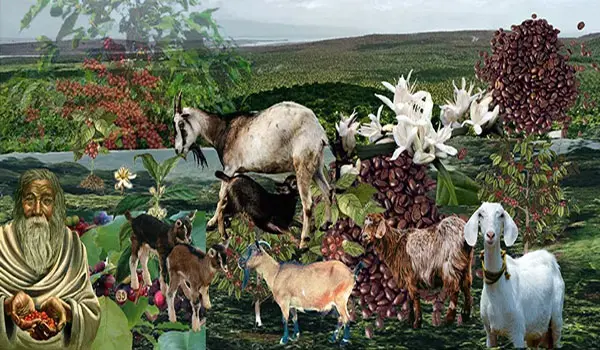Coffee history is essential to the coffee lover. A coffee thirsty can easily make a cup of coffee within a few minutes with a coffee maker. But it is not good if he doesn’t know the coffee history. I will love my father and not know about him, that is not possible. Also, I need to know the coffee history as I love coffee. However coffee is a popular and beloved beverage globally. But Before, coffee was not as tasty and fragrant as it is now. There is a big and complex history behind the rich and favorable coffee. In this exploration of coffee history, we will discuss into the origins, spread, and cultural impact of this beloved coffee. Let’s start on a journey through time, savoring the aroma of the past and the promise of the future. Continue reading for details of coffee history.

An Ethiopian Legend in Coffee history
Exactly it is very difficult to discover the coffee origin in the coffee history. Actually, none can say accurately how or when coffee was discovered. Throughout the annals of history, some say that the Ethiopians invented coffee at first in their plateau. Some think that all credit goes to the Ethiopian goat herder Kaldi with the invention of coffee. There is a story in this coffee history. Many people in the world think it is a fable. Legend has it, that Kaldi used to go to the field taking rice pot and water for grazing goats. But Kaldi sees his goats are eating newfound fruits from a specific tree. After that, they become vivacious. Remarkably, these enigmatic fruits seemed to bestow boundless energy upon the goats, rendering them uninterested in slumber during the night.
Kaldi, in his curiosity and awe, diligently reported his observations to the venerable abbot presiding over the nearby monastery. Then the conscious abbot, intrigued by Kaldi’s account, starts on an experiment. He prepared a beverage from the enigmatic berries. And he was amazement, this elixir imbued him with unwavering alertness during the protracted hours of evening devotions.
The abbot recognizes the significance of his discovery. After that, he graciously imparted this newfound knowledge to his monastic brethren. Thus initiating the diffusion of awareness regarding these invigorating berries. As the story crossed the borders and traversed eastward to the Arabian peninsula. It commenced a momentous odyssey destined to carry these extraordinary beans to the far reaches of the world.
Cradle of coffee cultivation and trade In Arabian Peninsula
The Arabian Peninsula served as the cradle of coffee cultivation and trade. As the 15th century unfolded, coffee plantations thrived in the Yemeni region of Arabia. By the 16th century, the aromatic brew had gained recognition in distant lands, including Persia, Egypt, Syria, and Turkey.
This intriguing elixir didn’t confine itself to private homes. It found a second home in bustling public establishments known as “qahveh khaneh” or coffee houses. That time many coffee shop was sprouted in urban centers throughout the Near East. These coffee houses quickly became unparalleled hubs of social interaction.
Patrons didn’t merely savor coffee and engage in discourse; they immersed themselves in a diverse tapestry of activities.
The ripple effect of coffee’s allure extended even further, as thousands of pilgrims from all corners of the globe flocked to the holy city of Mecca each year. Here, the fame of this exotic beverage, often referred to as the “wine of Araby,” began its inexorable journey across the world.
When Coffee Comes to Europe
European travelers returning from the East brought back an unusual enigmatic dark black beverage in their compatriots.
As the 17th century dawned, coffee began to weave its enchanting spell across the European landscape. At this time the Europeans thought,” it was dangerous for them and it is harmful to health. Besides this, they used to think that it was a bitter invention of Satan”. In the Venetian realm, local clergy vehemently decried the introduction of coffee in 1615. The ensuing controversy was so tumultuous that it prompted an appeal to Pope Clement VIII for resolution. In a moment of pivotal decision-making, the Pope chose to personally partake of the brew before passing judgment. To his astonishment, he found the libation not only palatable but deeply gratifying, bestowing upon it his papal blessing.
Notwithstanding the initial tumult, coffee houses swiftly emerged as bustling epicenters of social interaction and information exchange in the major urban centers of England, Austria, France, Germany, and Holland. In England, these establishments earned the moniker “penny universities”. Because, for the modest sum of a penny, one could acquire a cup of coffee and engage in intellectual discourse.
Before the coffee era, people used to drink beer and wine with heightened alertness and vitality. But they didn’t get so much energy. In the coffee era, they started to drink coffee and they felt better. Unsurprisingly, this transition resulted in a notable enhancement of their work productivity. Even, coffee service is a precursor and very popular in the modern office.
By the midpoint of the 17th century, the cityscape of London boasted an impressive tally of over 300 coffee houses. These were very attractive for the merchants, shippers, brokers, and artists.
From the crucible of these specialized coffee houses, many notable enterprises found their genesis, with Lloyd’s of London.
Plantations the coffee plant Around the World
As the demand for this beverage continued to expand, an intense rivalry unfurled to nurture coffee beyond the confines of Arabia.
The Dutch were persistently trying to put a foothold in the competition. Finally, they secured coffee seedlings in the latter half of the 17th century. Their initial endeavors to cultivate these precious saplings on Indian soil met with disappointment. However, their tenacity bore fruit when they achieved success in Batavia, situated on the island of Java, now part of Indonesia.
In this new setting, the coffee plants flourished with remarkable vigor, endowing the Dutch with a burgeoning and prosperous coffee trade. Emboldened by their achievements, they extended their cultivation efforts to the lush islands of Sumatra and Celebes.
How to Come coffee in America
In coffee history, there was no sign of coffee grounds in America before 1714. The Mayor of Amsterdam gifted a coffee plant to King Louis XIV of France, who had it planted in the Royal Botanical Garden in Paris in 1714.

In 1723, Gabriel de Clieu, a naval officer, successfully obtained a seedling from the King’s plant, despite facing various challenges during his journey. He brought the seedling to Martinique, where it thrived and eventually gave rise to 18 million coffee trees on the island. This seedling also became the ancestor of all coffee trees in the Caribbean, South America, and Central America.
The Brazilian coffee industry owes its existence to Francisco de Mello Palheta, who acquired coffee seedlings from French Guiana. The French initially resisted parting with their coffee seeds but relented due to Palheta’s charm. These seeds marked the beginning of a billion-dollar coffee enterprise.
Throughout the 18th century, missionaries, explorers, traders, and colonists spread coffee seeds worldwide. Coffee plantations emerged in various environments, some flourishing while others faced challenges. Entire nations built their economies on coffee, making it the second most valuable global export commodity after crude oil by the century’s end. Coffee became a coveted treasure in the world of trade. As a result, coffee is rolling in every kitchen today.
After that, coffee gradually spread all over the world and the coffee put a sign in the heart of people. People learn how to take it, and how to prepare for drinking. Before, people used the oven for ready coffee. But in the modern era, people use coffee makers like Keurig 2.0 Coffee Maker and Dual Coffee Maker, etc.
Why coffee is popular in todays world
In today’s fast-paced world, coffee has emerged as a beloved and immensely popular beverage. Because there are many benefits of coffee drinking.
Firstly, coffee’s invigorating properties provide a much-needed energy boost.
Secondly, it helps people stay alert and focused during their busy daily routines.
Moreover, the rich aroma and comforting warmth of a freshly brewed cup of coffee create a sensory experience. It also transcends cultures, making it a universal favorite. Coffee shops and cafes have become social hubs, fostering connections and conversations in an increasingly digital age.
Additionally, coffee is celebrated for its potential health benefits, such as antioxidants and potential cognitive improvements. With a variety of flavors, and brewing methods, coffee continues to evolve and captivate. As a result, a global audience, cementing coffee’s place as an enduring symbol of modern living.

[…] Let’s discover the epitome of culinary excellence in Diamond Cookware over a cup of coffee. Crafted with precision and innovation, our cookware collection embodies the perfect fusion of […]
[…] the immersion blender into the bottom of a tall and narrow container, you may grind coffee beans for 20 to 30 […]
[…] Modori Cookware is synonymous with unparalleled quality. Crafted with precision and designed for durability, each piece is a testament to the brand’s commitment to excellence. With an emphasis on using premium materials, Modori ensures that every pan, pot, and utensil is built to last like Swiss diamond cookware. […]
[…] Copper bottom pots: Tea Coffee Pan, Milk […]
[…] problem, Let’s take a cup of coffee and see the solution. Don’t Look further the back! Tramontina stainless steel cookware is here […]
[…] Bosch microwaves, and how they can enhance the modern kitchen experience. So, let’s take a cup of coffee and dive in and discover why Bosch microwaves are a top choice for those seeking a reliable and […]
[…] with floor espresso. It also has a detachable clear-out basket for smooth cleaning. Overall, the Mr. Coffee Brew now or later gives a handy and smooth manner to brew a sparkling pot of espresso, whether or […]
[…] process that ensures the longevity and performance of the product. Here’s where we will take coffee and see a step-by-step guide […]
[…] you like to make your art look old-fashioned or well-used? Dip a brush or sponge into strong coffee and apply it to your paper or fabric. The natural substances in coffee will color the surface, […]
[…] taking coffee, stop the coffee maker and discard the used coffee grounds and filter. To clean the machine and other parts quickly, you can use soap and warm water for […]